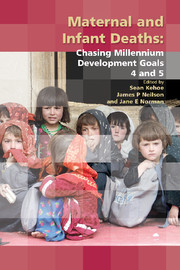Book contents
- Frontmatter
- Contents
- Participants
- Declaration of personal interests
- Preface
- The Millennium Development Goals
- SECTION 1 THE SIZE OF THE PROBLEM
- SECTION 2 CLINICAL PROBLEMS AND SOLUTIONS – MATERNAL
- 5 Postpartum haemorrhage
- 6 Reducing deaths from hypertensive disorders of pregnancy
- 7 Obstructed labour (including partograms)
- 8 Puerperal sepsis in low- and middle-income settings: past, present and future
- 9 Unsafe abortion and strategies to reduce its impact on women's lives
- 10 HIV and tuberculosis
- 11 A pragmatic approach to safe anaesthesia
- SECTION 3 CLINICAL PROBLEMS AND SOLUTIONS – NEONATAL
- SECTION 4 TRAINING AND DEVELOPMENT
- SECTION 5 SPECIFIC CHALLENGES IN SPECIFIC COUNTRIES
- SECTION 6 CONSENSUS VIEWS
- Index
6 - Reducing deaths from hypertensive disorders of pregnancy
from SECTION 2 - CLINICAL PROBLEMS AND SOLUTIONS – MATERNAL
Published online by Cambridge University Press: 05 February 2014
- Frontmatter
- Contents
- Participants
- Declaration of personal interests
- Preface
- The Millennium Development Goals
- SECTION 1 THE SIZE OF THE PROBLEM
- SECTION 2 CLINICAL PROBLEMS AND SOLUTIONS – MATERNAL
- 5 Postpartum haemorrhage
- 6 Reducing deaths from hypertensive disorders of pregnancy
- 7 Obstructed labour (including partograms)
- 8 Puerperal sepsis in low- and middle-income settings: past, present and future
- 9 Unsafe abortion and strategies to reduce its impact on women's lives
- 10 HIV and tuberculosis
- 11 A pragmatic approach to safe anaesthesia
- SECTION 3 CLINICAL PROBLEMS AND SOLUTIONS – NEONATAL
- SECTION 4 TRAINING AND DEVELOPMENT
- SECTION 5 SPECIFIC CHALLENGES IN SPECIFIC COUNTRIES
- SECTION 6 CONSENSUS VIEWS
- Index
Summary
Introduction
Hypertensive disorders of pregnancy (HDP) are among the most important causes of maternal death worldwide. HDP are responsible for 16.1% of maternal deaths in high-income countries, for 9.1% of maternal deaths in Africa and Asia and for 25.7% of maternal deaths in Latin America.
As examples of high-income countries, in the UK there were 18 maternal deaths due to HDP of a total of 132 direct deaths (13.6%) during 2003—05. Ten mothers died because of intracranial haemorrhage, two because of cerebral infarct and six had liver complications.
In South Africa, as an example of a middle-income country, the fourth confidential enquiry into maternal deaths from 2005—07 reported 622 maternal deaths due to HDP, which was 15.7% of the total of 3959 maternal deaths, and 34.2% of direct maternal deaths. The deaths were subclassified as being due to eclampsia (55.3%), pre-eclampsia (27.8%), HELLP syndrome (haemolysis, elevated liver enzymes, low platelets) (8.7%), chronic hypertension (6.1%) and other causes (2.1%). The commonly reported final causes of death were cerebral haemorrhage (45.5%), respiratory failure including adult respiratory distress syndrome (ARDS) (25.4%), cardiac failure including pulmonary oedema (22.8%), multiple organ failure (14.1%), disseminated intravascular coagulopathy (DIC) (14.1%), renal failure (10.3%) and liver failure (4.8%).
In Kerala, India, as an example of a low-income country, HDP, with 41 deaths (13.4%), were the second most common cause of maternal death after obstetric haemorrhage (19.8%).
- Type
- Chapter
- Information
- Maternal and Infant DeathsChasing Millennium Development Goals 4 and 5, pp. 99 - 114Publisher: Cambridge University PressPrint publication year: 2010



